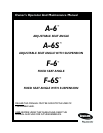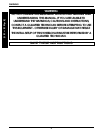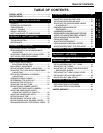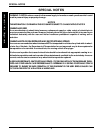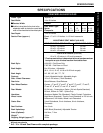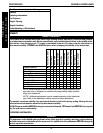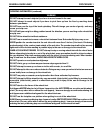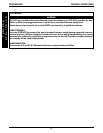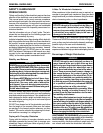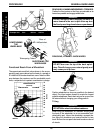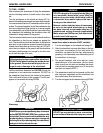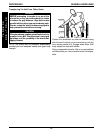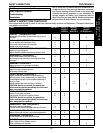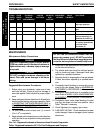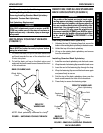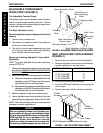
9
SAFETY/HANDLING OF
WHEELCHAIRS
“Safety and Handling” of the wheelchair requires the close
attention of the wheelchair user as well as the assistant.
This manual points out the most common procedures
and techniques involved in the safe operation and main-
tenance of the wheelchair. It is important to practice and
master these safe techniques until you are comfortable
in maneuvering around the frequently encountered ar-
chitectural barriers.
Use this information only as a “basic” guide. The tech-
niques that are discussed on the following pages have
been used successfully by many.
Individual wheelchair users often develop skills to deal with
daily living activities that may differ from those described in
this manual. Invacare recognizes and encourages each
individual to try what works best for him/her in overcoming
architectural obstacles that they may encounter, however
ALL WARNINGS and CAUTIONS given in this manual
MUST be followed. Techniques in this manual are a start-
ing point for the new wheelchair user and assistant with
“safety” as the most important consideration for all.
Stability and Balance
WARNING
ALWAYS wear your seat positioning strap. Inasmuch
as the SEAT POSITIONING STRAP is an option on this
wheelchair (You may order with or without the seat
positioning strap), Invacare strongly recommends
ordering the seat positioning strap as an additional
safeguard for the wheelchair user.
Anti-tippers MUST BE attached at all times. Inas-
much as the ANTI-TIPPERS are an option on this
wheelchair (You may order with or without the
anti-tippers), Invacare strongly recommends or-
dering the anti-tippers as an additional safeguard
for the wheelchair user.
To assure stability and proper operation of your wheel-
chair, you must at all times wear your seat positioning
strap and maintain proper balance. Your wheelchair has
been designed to remain upright and stable during nor-
mal daily activities as long as you do not move beyond
the center of gravity.
DO NOT lean forward out of the wheelchair any further
than the length of the armrests. Make sure the casters
are pointing in the forward position whenever you lean
forward. This can be achieved by advancing the wheel-
chair and then reversing it in a straight line.
Coping with Everyday Obstacles
Coping with the irritation of everyday obstacles can be
alleviated somewhat by learning how to manage your
wheelchair. Keep in mind your center of gravity to main-
tain stability and balance.
PROCEDURE 1
GENERAL GUIDELINES
G
E
N
E
R
A
L
G
U
I
D
E
L
I
N
E
S
A Note To Wheelchair Assistants
When assistance to the wheelchair user is required, re-
member to use good body mechanics. Keep your back
straight and bend your knees whenever tilting the wheel-
chair or traversing curbs, or other impediments.
WARNING
DO NOT attempt to lift a wheelchair by lifting on
any removable (detachable) parts. Lifting by
means of any removable (detachable) parts of
a wheelchair may result in injury to the user or
damage to the wheelchair.
Also, be aware of any removable (detachable) parts.
These must NEVER be used for hand-hold or lifting sup-
ports, as they may be inadvertently released, resulting in
possible injury to the user and/or assistant(s).
When learning a new assistance technique, have an
experienced assistant help you before attempting it alone.
Percentage of Weight Distribution
WARNING
DO NOT attempt to reach objects if you have to
move forward in the seat or pick them up from
the floor by reaching down between your knees.
Many activities require the wheelchair user to
reach, bend and transfer in and out of the wheel-
chair. These movements will cause a change to
the normal balance, the center of gravity, and
the weight distribution of the wheelchair. To de-
termine and establish your particular safety lim-
its, practice bending, reaching and transferring
activities in several combinations in the presence
of a qualified healthcare professional BEFORE
attempting active use of the wheelchair.
Proper positioning is essential for your safety. When
reaching, leaning, or bending forward, it is im-
portant to use the front casters as a tool to main-
tain stability and balance.
The position of the footrest, seat angle, back angle,
seating system/upholstery, caster size and position,
rear wheel size and position, anti-tippers, as well as
the user condition directly relate to the stability of
the wheelchair. Any change to one (1) or any com-
bination of the ten (10) may cause the wheelchair
to decrease in stability. EXTREME care MUST be taken
when changing the stability of the wheelchair.
LENGTHENING THE WHEELBASE will increase the stabil-
ity and maintain standard maneuverability of the wheelchair.
SHORTENING THE WHEELBASE will increase the
maneuverability, distribute additional weight onto the
rear wheels and make the wheelchair less stable.



